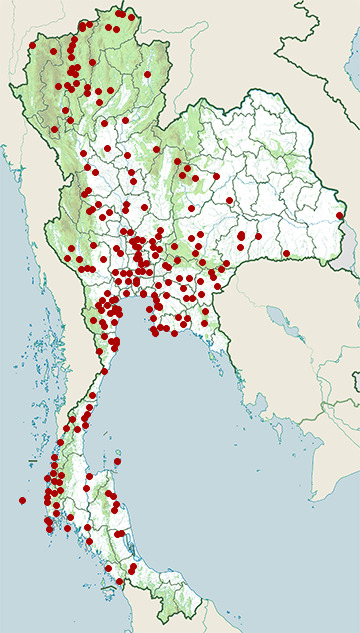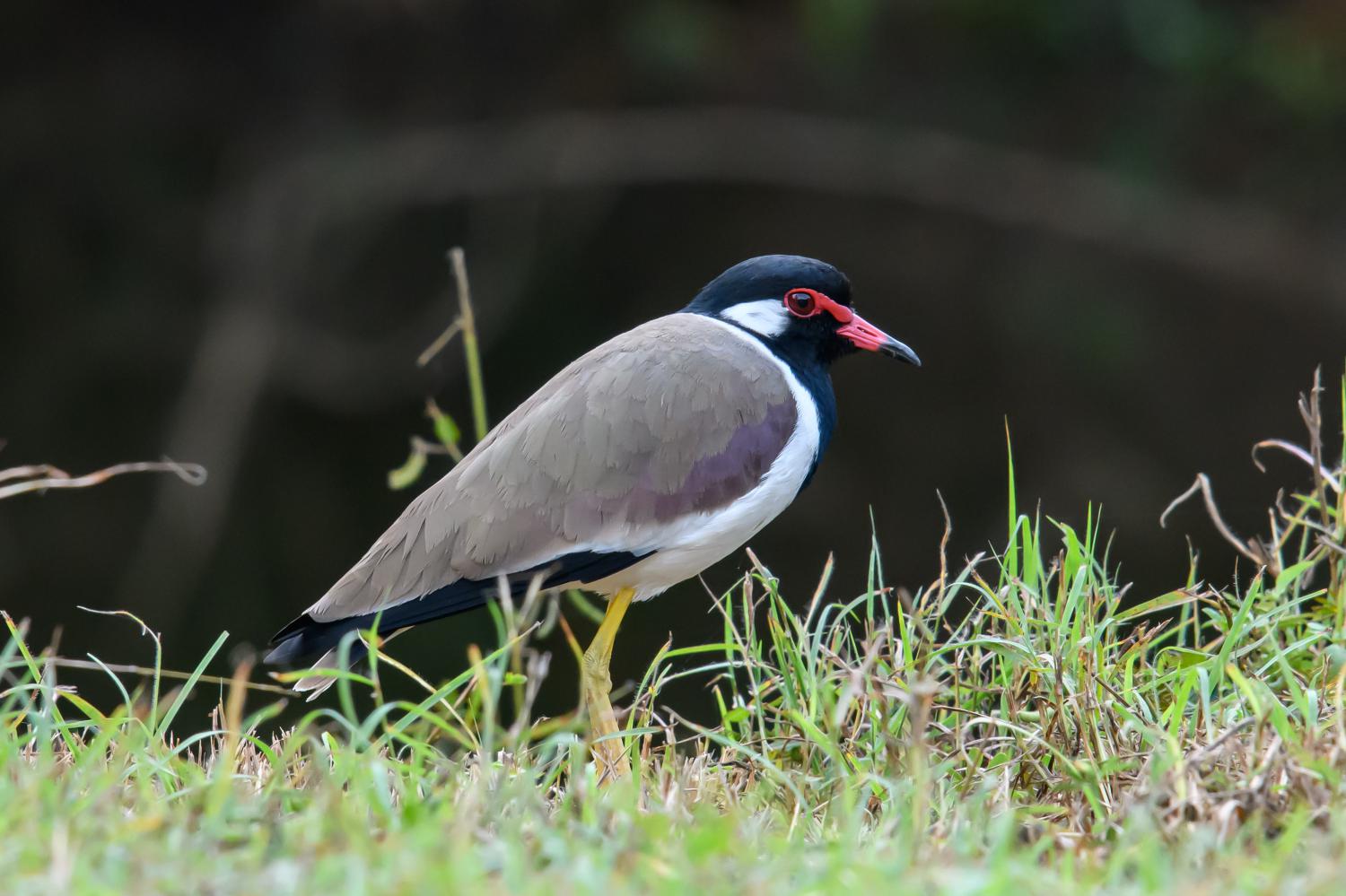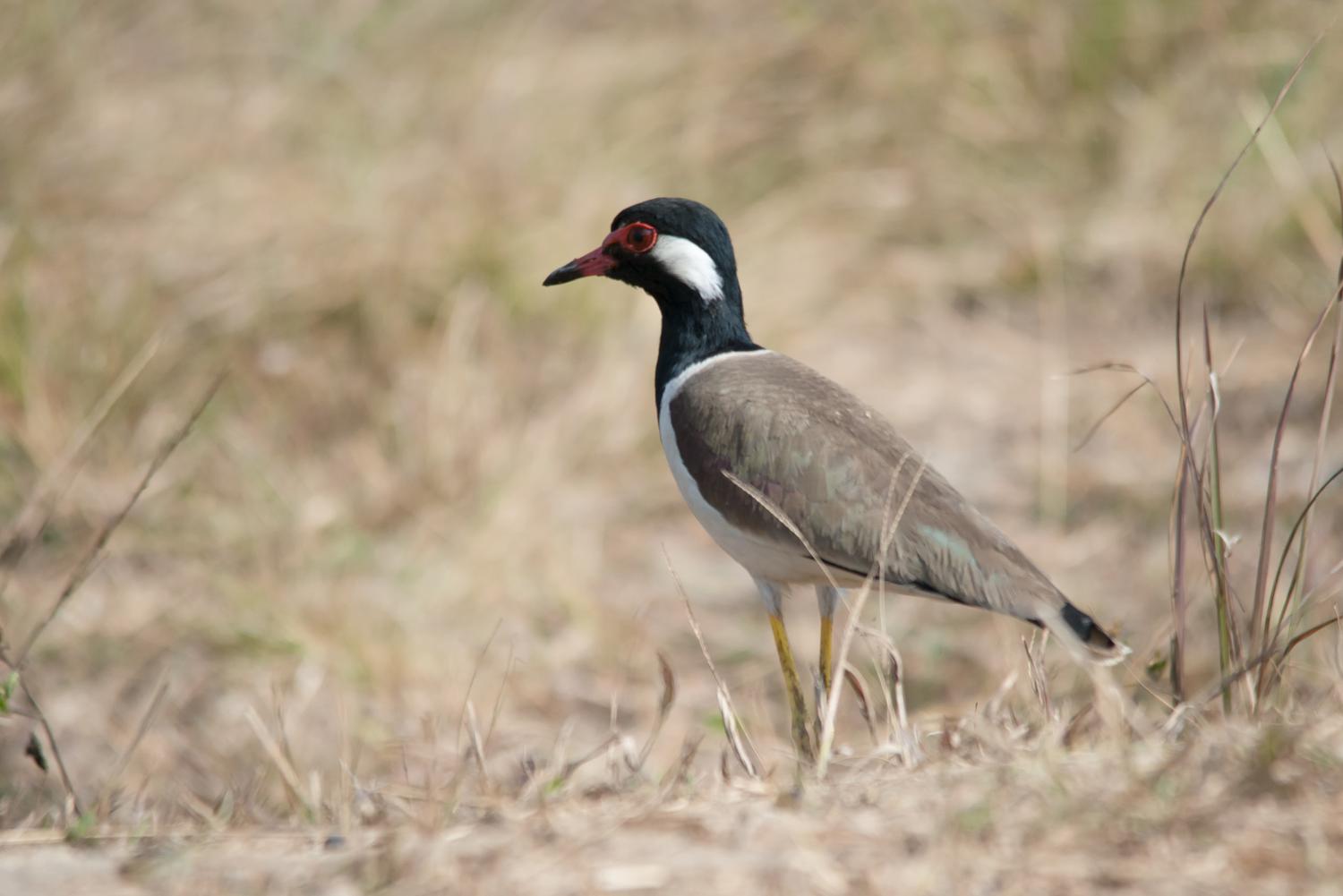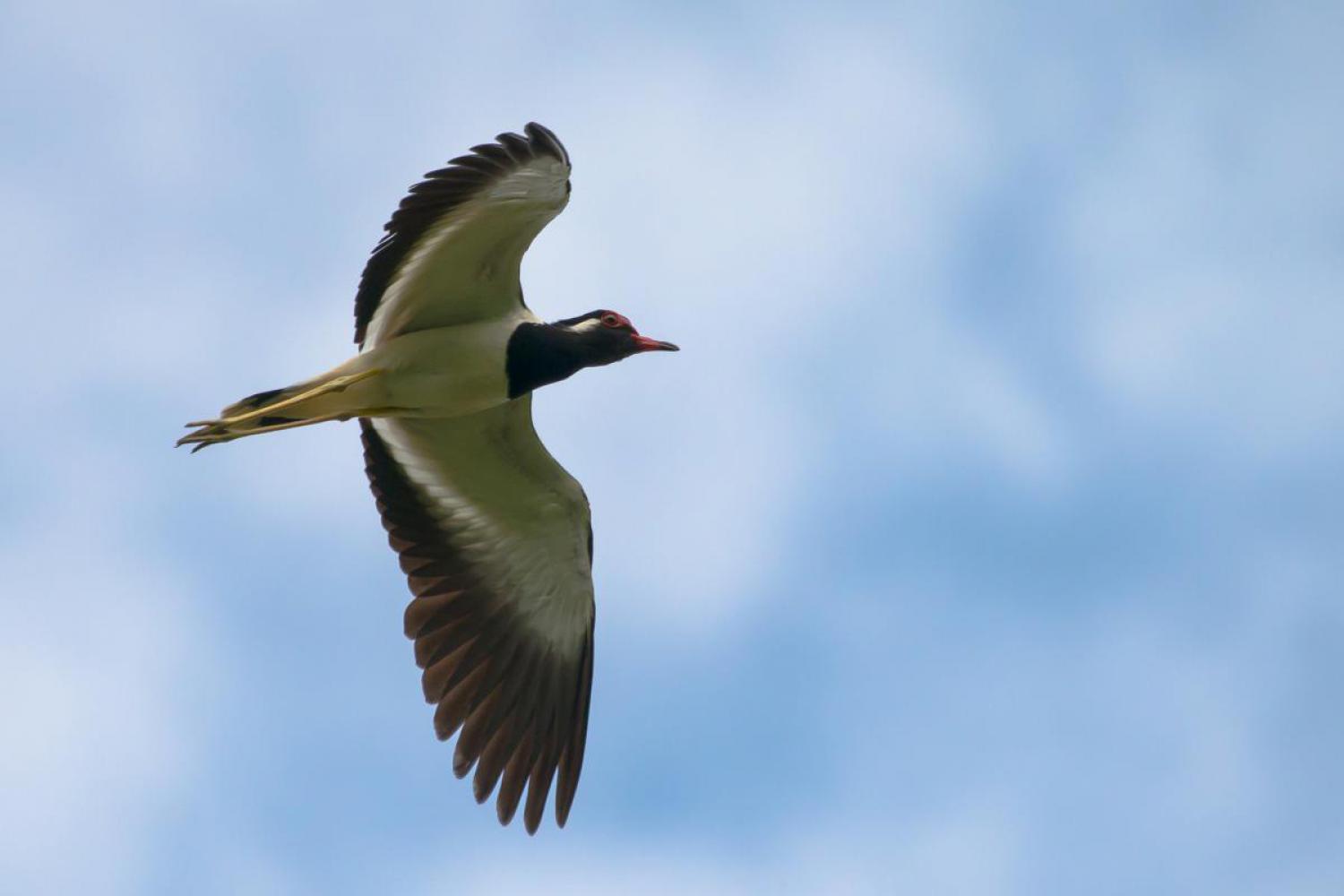Species of Thailand
Red-wattled lapwing
Vanellus indicus
Pieter Boddaert, 1783
In Thai: นกกระแตแต้แว้ด
The red-wattled lapwing (Vanellus indicus) is an Asian lapwing or large plover, a wader in the family Charadriidae. Like other lapwings they are ground birds that are incapable of perching. Their characteristic loud alarm calls are indicators of human or animal movements and the sounds have been variously rendered as did he do it or pity to do it leading to the colloquial name of did-he-do-it bird. Usually seen in pairs or small groups and usually not far from water they sometimes form large aggregations in the non-breeding season (winter). They nest in a ground scrape laying three to four camouflaged eggs. Adults near the nest fly around, diving at potential predators while calling noisily. The cryptically patterned chicks hatch and immediately follow their parents to feed, hiding by lying low on the ground or in the grass when threatened.
Taxonomy
Traditionally well known to native hunters, the red-wattled lapwing was first described in a book by the French polymath Georges-Louis Leclerc, Comte de Buffon in his Histoire Naturelle des Oiseaux in 1781. The bird was also illustrated in a hand-coloured plate engraved by François-Nicolas Martinet in the Planches Enluminées D'Histoire Naturelle produced under the supervision of Edme-Louis Daubenton to accompany Buffon's text. Neither the plate nor Buffon's description included a scientific name but in 1783 the Dutch naturalist Pieter Boddaert used the binomial name Tringa indica in his catalogue of the Planches Enluminées. The type locality is Goa in western India. It was subsequently placed in various other genera such as Sarcogrammus and Lobivanellus before being merged into Vanellus which was erected by the French zoologist Mathurin Jacques Brisson in 1760. Vanellus is the Medieval Latin for a "lapwing". It is a diminutive of the Latin vanus meaning "winnowing" or "fan". The specific epithet indicus is the Latin for "India".
Across their wide range there are slight differences in the plumage and there are four recognized subspecies:
- V. i. aigneri (Laubmann, 1913) – southeast Turkey to Pakistan
- V. i. indicus (Boddaert, 1783) – central Pakistan to Nepal, northeast India and Bangladesh
- V. i. lankae (Koelz, 1939) – Sri Lanka
- V. i. atronuchalis (Jerdon, 1864) – northeast India to south China, southeast Asia, Malay Peninsula and north Sumatra
Description
Red-wattled lapwings are large waders, about 35 cm long. The wings and back are light brown with a purple to green sheen, but the head, a bib on the front and back of the neck are black. Prominently white patch runs between these two colours, from belly and tail, flanking the neck to the sides of crown. Short tail is tipped black. A red fleshy wattle in front of each eye, black-tipped red bill, and the long legs are yellow. In flight, prominent white wing bars formed by the white on the secondary coverts.
Race aigneri is slightly paler and larger than the nominate race and is found in Turkey, Iran, Iraq, Afghanistan and the Indus valley. The nominate race is found all over India. The Sri Lankan race lankae is smaller and dark while atronuchalis the race in north-eastern India and eastern Bangladesh has a white cheek surrounded by black.
Males and females are similar in plumage but males have a 5% longer wing and tend to have a longer carpal spur. The length of the birds is 320–350 mm, wing of 208–247 mm with the nominate averaging 223 mm, Sri Lanka 217 mm. The Bill is 31–36 mm and tarsus of 70–83 mm. Tail length is 104–128 mm.
It usually keeps in pairs or trios in well-watered open country, ploughed fields, grazing land, and margins and dry beds of tanks and puddles. They occasionally form large flocks, ranging from 26 to 200 birds. It is also found in forest clearings around rain-filled depressions. It runs about in short spurts and dips forward obliquely (with unflexed legs) to pick up food in a typical plover manner. They are said to feed at night being especially active around the full moon. Is uncannily and ceaselessly vigilant, day or night, and is the first to detect intrusions and raise an alarm, and was therefore considered a nuisance by hunters. Flight rather slow, with deliberate flaps, but capable of remarkable agility when defending nest or being hunted by a hawk.
Its striking appearance is supplemented by its noisy nature, with a loud and scolding did-he-do-it call, uttered both in the day and night.
Leucistic abnormal plumages have been noted.
The local names are mainly onomatopoeic in origin and include titeeri (Hindi), titawi (Marathi), tittibha (Kannada), tateehar (Sindhi), titodi (Gujarati), hatatut (Kashmiri), balighora (Assamese), yennappa chitawa (Telugu), aal-kaati (Tamil, meaning "human indicator").
Distribution
It breeds from West Asia (Iraq, SW Iran, Persian Gulf) eastwards across South Asia (Baluchistan, Sri Lanka, Afghanistan, Pakistan, the entire Indian subcontinent up to Kanyakumari and up to 1800m in Kashmir/Nepal), with another sub-species further east in Southeast Asia. May migrate altitudinally in spring and autumn (e.g. in N. Baluchistan or NW Pakistan), and spreads out widely in the monsoons on creation of requisite habitats, but by and large the populations are resident.
This species is declining in its western range, but is abundant in much of South Asia, being seen at almost any wetland habitat in its range.
Behaviour and ecology
The breeding season is mainly March to August. The courtship involves the male puffing its feathers and pointing its beak upwards. The male then shuffles around the female. Several males may display to females and they may be close together. The eggs are laid in a ground scrape or depression sometimes fringed with pebbles, goat or hare droppings. About 3–4 black-blotched buff eggs shaped a bit like a peg-top (), 42x30 mm on average. Nests are difficult to find since the eggs are cryptically coloured and usually matches the ground pattern. In residential areas, they sometimes take to nesting on roof-tops. They have been recorded nesting on the stones between the rails of a railway track, the adult leaving the nest when trains passed. Nests that have been threatened by agricultural operations have been manually translocated by gradually shifting the eggs. When nesting they will attempt to dive bomb or distract potential predators. Both the male and female incubate the eggs and divert predators using distraction displays or flash their wings to deter any herbivores that threaten the nest. Males appear to relieve females incubating at the nest particularly towards the hot part of noon. The eggs hatch in 28 to 30 days. The reproductive success is about 40%. Egg mortality is high (~43%) due to predation by mongooses, crows and kites. Chicks have a lower mortality (8.3%) and their survival improves after the first week.
Like other lapwings, they soak their belly feathers to provide water to their chicks as well as to cool the eggs during hot weather.
They bathe in pools of water when available and will often spend time on preening when leaving the nest or after copulation. They sometimes rest on the ground with the tarsi laid flat on the ground and at other times may rest on one leg.
Healthy adult birds have few predators and are capable of rapid and agile flight when pursued by hawks or falcons. Some endoparasitic tapeworms, nematodes, and trematodes have been described from the species. Mortality caused by respiratory infection by Ornithobacterium rhinotracheale has been recorded in captive birds in Pakistan.
Diet
The diet of the lapwing includes a range of insects, snails and other invertebrates, mostly picked from the ground. They may also feed on some grains. They feed mainly during the day but they may also feed at night. They may sometimes make use of the legs to disturb insect prey from soft soil.
In culture
In parts of India, a local belief is that the bird sleeps on its back with the legs upwards and an associated Hindi metaphor Tithiri se asman thama jayega ("can the lapwing support the heavens?") is used to refer to persons undertaking tasks beyond their ability or strength.
In parts of Rajasthan it is believed that the laying of eggs by the lapwing on high ground was an indication of good rains to come. The eggs are known to be collected by practitioners of folk medicine. The Bhils of Malwa believed that the laying of eggs by red-wattled lapwings in the dry beds of streams as forewarnings of delayed rains or droughts. Eggs laid on the banks on the other hand were taken as indications of normal rains.
Other sources
- Anon. (1991) Flocking of Red Wattled Lapwings. Newsletter for Birdwatchers 31(5–6):1.
- Dharmakumarsinhji, RS (1965) Small displacement by ground nesting birds. Newsletter for Birdwatchers 5(9):10.
- Jamdar, Nitin (1985) Journal of the Bombay Natural History Society 82(1):197.
- Kalsi, RS; Khera, S (1986) Some observations on breeding and displacement behaviour of the Redwattled Lapwing Vanellus indicus indicus (Aves: Charadriidae). Res. Bull. Panjab Univ. 37:131–141.
- Khajuria, H (1972) Nestlings of the redwattled lapwing, Vanellus i. indicus (boddaert). Pavo 8(1&2):82–83.
- Koshy, MS (1989) Lapwings on a roof. Newsletter for Birdwatchers 29(7–8):7.
- Krishnan, M (1998) Ubiquitous alarmist. Blackbuck. 14(3&4):88–90.
- Jackson, P (1976) Redwattled Lapwing. Newsletter for Birdwatchers 16(3):11–12.
- Saxena, VS (1973) Unusual nesting by Redwattled Lapwing. Indian Forester 99:33–35.
This article uses material from Wikipedia released under the Creative Commons Attribution-Share-Alike Licence 3.0. Eventual photos shown in this page may or may not be from Wikipedia, please see the license details for photos in photo by-lines.
Category / Seasonal Status
BCST Category: Recorded in an apparently wild state within the last 50 years
BCST Seasonal status: Resident or presumed resident
Scientific classification
- Kingdom
- Animalia
- Phylum
- Chordata
- Class
- Aves
- Order
- Charadriiformes
- Family
- Charadriidae
- Genus
- Vanellus
- Species
- Vanellus indicus
Common names
- English:
- Red-wattled lapwing
- Red-wattled plover
- Thai: นกกระแตแต้แว้ด
Synonyms
- Sarcogrammus indicus
- Tringa indica
- Lobivanellus goensis
- Lobivanellus indicus
- Hoplopterus indicus
Conservation status

Least Concern (IUCN3.1)
Photos
Please help us review the bird photos if wrong ones are used. We can be reached via our contact us page.
Range Map

- Amphawa District, Samut Songkhram
- Ao Phang-Nga National Park
- Aranyaprathet District, Sa Kaeo
- Ban Chang District, Rayong
- Ban Laem District, Phetchaburi
- Ban Lat District, Phetchaburi
- Ban Phraek District, Phra Nakhon Si Ayutthaya
- Bang Ban District, Phra Nakhon Si Ayutthaya
- Bang Lamung District, Chonburi
- Bang Len District, Nakhon Pathom
- Bang Pa In District, Phra Nakhon Si Ayutthaya
- Bang Pahan District, Phra Nakhon Si Ayutthaya
- Bang Pakong District, Chachoengsao
- Bang Phra Non-Hunting Area
- Bang Pu Recreation Centre
- Bang Saphan Noi District, Prachuap Khiri Khan
- Bangkok Province
- Bueng Boraped Non-Hunting Area
- Chaiyo District, Ang Thong
- Chaloem Phra Kiat District, Saraburi
- Chaloem Phrakiat Thai Prachan National Park
- Chatturat District, Chaiyaphum
- Chiang Dao District, Chiang Mai
- Chiang Dao Wildlife Sanctuary
- Chiang Khong District, Chiang Rai
- Chiang Saen District, Chiang Rai
- Chum Ta Bong District, Nakhon Sawan
- Doi Inthanon National Park
- Doi Khun Tan National Park
- Doi Lo District, Chiang Mai
- Doi Pha Hom Pok National Park
- Doi Suthep - Pui National Park
- Doi Tao District, Chiang Mai
- Don Chedi District, Suphan Buri
- Erawan National Park
- Fang District, Chiang Mai
- Hang Chat District, Lampang
- Hat Wanakon National Park
- Hat Yai District, Songkhla
- Hua Hin District, Prachuap Khiri Khan
- Huai Chorakhe Mak Reservoir Non-Hunting Area
- Huai Kha Khaeng Wildlife Sanctuary
- Huai Krachao District, Kanchanaburi
- Huai Sala Wildlife Sanctuary
- Huai Talat Reservoir Non-Hunting Area
- In Buri District, Sing Buri
- Kabin Buri District, Prachinburi
- Kaeng Khoi District, Saraburi
- Kaeng Krachan District, Phetchaburi
- Kaeng Krachan National Park
- Kamphaeng Saen District, Nakhon Pathom
- Kapong District, Phang Nga
- Kaset Sombun District, Chaiyaphum
- Khao Ang Rue Nai Wildlife Sanctuary
- Khao Chamao - Khao Wong National Park
- Khao Dinsor (Chumphon Raptor Center)
- Khao Khiao - Khao Chomphu Wildlife Sanctuary
- Khao Khitchakut National Park
- Khao Laem Ya - Mu Ko Samet National Park
- Khao Lak - Lam Ru National Park
- Khao Nan National Park
- Khao Nang Phanthurat Forest Park
- Khao Phra - Bang Khram Wildlife Sanctuary
- Khao Sam Roi Yot National Park
- Khao Sanam Prieng Wildlife Sanctuary
- Khao Soi Dao Wildlife Sanctuary
- Khao Sok National Park
- Khao Yai National Park
- Khao Yoi District, Phetchaburi
- Khlong Hoi Khong District, Songkhla
- Khlong Luang District, Pathum Thani
- Khlong Phanom National Park
- Khlong Saeng Wildlife Sanctuary
- Khon San District, Chaiyaphum
- Khuan Khanun District, Phatthalung
- Khun Chae National Park
- Khura Buri District, Phang Nga
- Klaeng District, Rayong
- Ko Phra Thong
- Ko Samui District, Surat Thani
- Ko Sichang District, Chonburi
- Kra Buri District, Ranong
- Kromluang Chumphon Wildlife Sanctuary
- Kui Buri National Park
- La-ngu District, Satun
- Laem Pak Bia
- Laem Son National Park
- Lan Sak District, Uthai Thani
- Mae Ai District, Chiang Mai
- Mae Mo District, Lampang
- Mae Ping National Park
- Mae Rim District, Chiang Mai
- Mae Taeng District, Chiang Mai
- Mae Tha, Lampang District, Lampang
- Mae Wong National Park
- Mu Ko Chumphon National Park
- Mueang Buriram District, Buriram
- Mueang Chachoengsao District, Chachoengsao
- Mueang Chiang Mai District, Chiang Mai
- Mueang Chiang Rai District, Chiang Rai
- Mueang Chonburi District, Chonburi
- Mueang Kamphaeng Phet District, Kamphaeng Phet
- Mueang Kanchanaburi District, Kanchanaburi
- Mueang Krabi District, Krabi
- Mueang Lampang District, Lampang
- Mueang Lamphun District, Lamphun
- Mueang Lopburi District, Lopburi
- Mueang Nakhon Nayok District, Nakhon Nayok
- Mueang Nakhon Pathom District, Nakhon Pathom
- Mueang Nakhon Ratchasima District, Nakhon Ratchasima
- Mueang Nakhon Si Thammarat District, Nakhon Si Thammarat
- Mueang Nan District, Nan
- Mueang Nonthaburi District, Nonthaburi
- Mueang Phang Nga District, Phang Nga
- Mueang Phetchaburi District, Phetchaburi
- Mueang Phichit District, Phichit
- Mueang Phitsanulok District, Phitsanulok
- Mueang Phuket District, Phuket
- Mueang Ranong District, Ranong
- Mueang Ratchaburi District, Ratchaburi
- Mueang Rayong District, Rayong
- Mueang Sa Kaeo District, Sa Kaeo
- Mueang Samut Sakhon District, Samut Sakhon
- Mueang Samut Songkhram District, Samut Songkhram
- Mueang Satun District, Satun
- Mueang Sukhothai District, Sukhothai
- Mueang Suphanburi District, Suphan Buri
- Mueang Surat Thani District, Surat Thani
- Mueang Surin District, Surin
- Mueang Tak District, Tak
- Mueang Uttaradit District, Uttaradit
- Nam Nao National Park
- Nam Phong National Park
- Namtok Sam Lan National Park
- Non Din Daeng District, Buriram
- Nong Bong Khai Non-Hunting Area
- Nong Prue District, Kanchanaburi
- Nong Song Hong District, Khon Kaen
- Nong Thung Thong Non-Hunting Area
- Nong Ya Plong District, Phetchaburi
- Nong Yai Area Development Project Under Royal Init
- Omkoi Wildlife Sanctuary
- Pa Sak Chonlasit Dam Non-Hunting Area
- Pa Sang District, Lamphun
- Pai District, Mae Hong Son
- Pak Chong District, Nakhon Ratchasima
- Pak Phli District, Nakhon Nayok
- Pak Thale
- Pak Tho District, Ratchaburi
- Pak Thong Chai District, Nakhon Ratchasima
- Pang Sida National Park
- Pang Sila Thong District, Kamphaeng Phet
- Pang Tong Royal Forest Park
- Pathio District, Chumphon
- Pha Daeng National Park
- Pha Taem National Park
- Phaisali District, Nakhon Sawan
- Phanat Nikhom District, Chonburi
- Phatthana Nikhom District, Lopburi
- Phayuha Khiri District, Nakhon Sawan
- Phi Phi Islands
- Phra Nakhon Si Ayutthaya District, Phra Nakhon Si Ayutthaya
- Phra Phrom District, Nakhon Si Thammarat
- Phu Hin Rong Kla National Park
- Phu Khiao Wildlife Sanctuary
- Phutthamonthon District, Nakhon Pathom
- Pran Buri District, Prachuap Khiri Khan
- Pran Buri Forest Park
- Ratchasan District, Chachoengsao
- Sai Noi District, Nonthaburi
- Sai Yok District, Kanchanaburi
- Sai Yok National Park
- Sakaerat Environmental Research Station
- Salak Pra Wildlife Sanctuary
- Samae San Island
- Samut Prakan Province
- San Sai District, Chiang Mai
- Sanam Bin Reservoir Non-Hunting Area
- Sanam Chai Khet District, Chachoengsao
- Sankhaburi District, Chainat
- Sattahip District, Chonburi
- Sawi District, Chumphon
- Si Maha Phot District, Prachinburi
- Si Racha District, Chonburi
- Si Satchanalai District, Sukhothai
- Sikao District, Trang
- Similan Islands
- Sirinat National Park
- Sri Nakarin Dam National Park
- Sri Phang Nga National Park
- Suk Samran District, Ranong
- Sung Noen District, Nakhon Ratchasima
- Ta Phraya National Park
- Takua Pa District, Phang Nga
- Taphan Hin District, Phichit
- Tha Chang District, Sing Buri
- Tha Sala District, Nakhon Si Thammarat
- Tha Takiap District, Chachoengsao
- Tha Wung District, Lopburi
- Tha Yang District, Phetchaburi
- Thai Mueang District, Phang Nga
- Thalang District, Phuket
- Thale Noi Non-Hunting Area
- Tham Pratun Non-Hunting Area
- Thanyaburi District, Pathum Thani
- Thao Kosa Forest Park
- Thap Lan National Park
- Thap Than District, Uthai Thani
- Wang Chan District, Rayong
- Wang Nam Yen District, Sa Kaeo
- Wang Noi District, Phra Nakhon Si Ayutthaya
- Wat Phai Lom & Wat Ampu Wararam Non-Hunting Area
- Wat Tham Erawan Non-Hunting Area
- Watthana Nakhon District, Sa Kaeo
- Wiang Chai District, Chiang Rai




